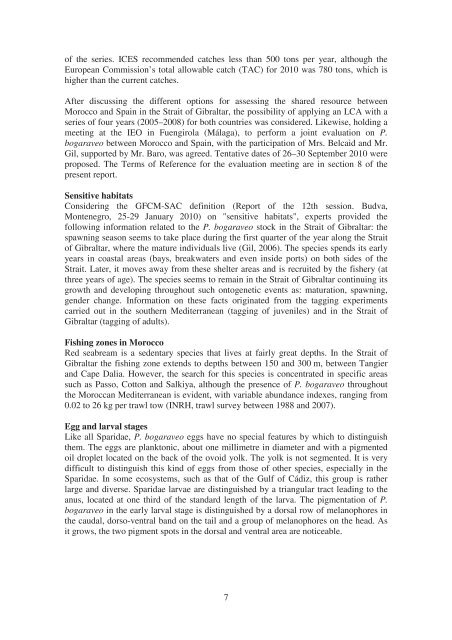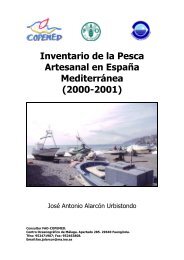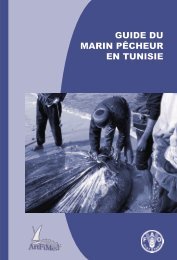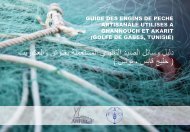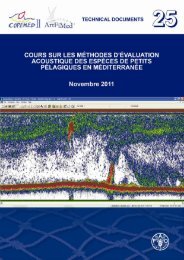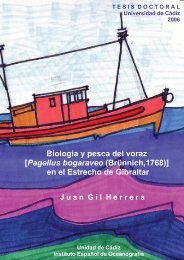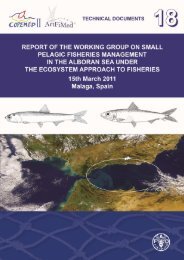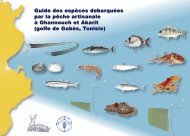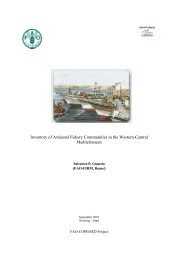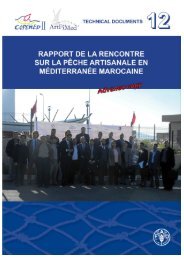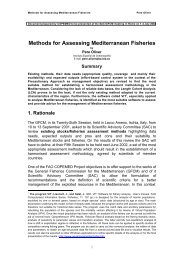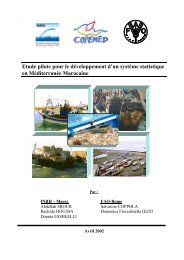Create successful ePaper yourself
Turn your PDF publications into a flip-book with our unique Google optimized e-Paper software.
of <strong>the</strong> series. ICES recommended catches less than 500 <strong>to</strong>ns per year, although <strong>the</strong><br />
European Commission’s <strong>to</strong>tal allowable catch (TAC) for 2010 was 780 <strong>to</strong>ns, which is<br />
higher than <strong>the</strong> current catches.<br />
After discussing <strong>the</strong> different options for assessing <strong>the</strong> shared resource between<br />
Morocco and Spain in <strong>the</strong> Strait of Gibraltar, <strong>the</strong> possibility of applying an LCA with a<br />
series of four years (2005–2008) for both countries was considered. Likewise, holding a<br />
meeting at <strong>the</strong> IEO in Fuengirola (Málaga), <strong>to</strong> perform a joint evaluation on P.<br />
bogaraveo between Morocco and Spain, with <strong>the</strong> participation of Mrs. Belcaid and Mr.<br />
Gil, supported by Mr. Baro, was agreed. Tentative dates of 26–30 September 2010 were<br />
proposed. The Terms of Reference for <strong>the</strong> evaluation meeting are in section 8 of <strong>the</strong><br />
present <strong>report</strong>.<br />
Sensitive habitats<br />
Considering <strong>the</strong> GFCM-SAC definition (Report of <strong>the</strong> 12th session. Budva,<br />
Montenegro, 25-29 January 2010) on "sensitive habitats", experts provided <strong>the</strong><br />
following information related <strong>to</strong> <strong>the</strong> P. bogaraveo s<strong>to</strong>ck in <strong>the</strong> Strait of Gibraltar: <strong>the</strong><br />
spawning season seems <strong>to</strong> take place during <strong>the</strong> first quarter of <strong>the</strong> year along <strong>the</strong> Strait<br />
of Gibraltar, where <strong>the</strong> mature individuals live (Gil, 2006). The species spends its early<br />
years in coastal areas (bays, breakwaters and even inside ports) on both sides of <strong>the</strong><br />
Strait. Later, it moves away from <strong>the</strong>se shelter areas and is recruited by <strong>the</strong> fishery (at<br />
three years of age). The species seems <strong>to</strong> remain in <strong>the</strong> Strait of Gibraltar continuing its<br />
growth and developing throughout such on<strong>to</strong>genetic events as: maturation, spawning,<br />
gender change. Information on <strong>the</strong>se facts originated from <strong>the</strong> tagging experiments<br />
carried out in <strong>the</strong> sou<strong>the</strong>rn Mediterranean (tagging of juveniles) and in <strong>the</strong> Strait of<br />
Gibraltar (tagging of adults).<br />
Fishing zones in Morocco<br />
Red seabream is a sedentary species that lives at fairly great depths. In <strong>the</strong> Strait of<br />
Gibraltar <strong>the</strong> fishing zone extends <strong>to</strong> depths between 150 and 300 m, between Tangier<br />
and Cape Dalia. However, <strong>the</strong> search for this species is concentrated in specific areas<br />
such as Passo, Cot<strong>to</strong>n and Salkiya, although <strong>the</strong> presence of P. bogaraveo throughout<br />
<strong>the</strong> Moroccan Mediterranean is evident, with variable abundance indexes, ranging from<br />
0.02 <strong>to</strong> 26 kg per trawl <strong>to</strong>w (INRH, trawl survey between 1988 and 2007).<br />
Egg and larval stages<br />
Like all Sparidae, P. bogaraveo eggs have no special features by which <strong>to</strong> distinguish<br />
<strong>the</strong>m. The eggs are plank<strong>to</strong>nic, about one millimetre in diameter and with a pigmented<br />
oil droplet located on <strong>the</strong> back of <strong>the</strong> ovoid yolk. The yolk is not segmented. It is very<br />
difficult <strong>to</strong> distinguish this kind of eggs from those of o<strong>the</strong>r species, especially in <strong>the</strong><br />
Sparidae. In some ecosystems, such as that of <strong>the</strong> Gulf of Cádiz, this group is ra<strong>the</strong>r<br />
large and diverse. Sparidae larvae are distinguished by a triangular tract leading <strong>to</strong> <strong>the</strong><br />
anus, located at one third of <strong>the</strong> standard length of <strong>the</strong> larva. The pigmentation of P.<br />
bogaraveo in <strong>the</strong> early larval stage is distinguished by a dorsal row of melanophores in<br />
<strong>the</strong> caudal, dorso-ventral band on <strong>the</strong> tail and a group of melanophores on <strong>the</strong> head. As<br />
it grows, <strong>the</strong> two pigment spots in <strong>the</strong> dorsal and ventral area are noticeable.<br />
7


